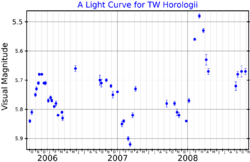Astronomy:TW Horologii
| Observation data Equinox J2000.0]] (ICRS) | |
|---|---|
| Constellation | Horologium |
| Right ascension | 03h 12m 33.16062s[2] |
| Declination | −57° 19′ 17.5710″[2] |
| Apparent magnitude (V) | 5.71[3] (5.52 to 5.95)[4] |
| Characteristics | |
| Spectral type | C-N4IIIb: (C23.5)[5] |
| U−B color index | +2.93[6] |
| B−V color index | +2.419±0.014[3] |
| Variable type | SRb[4] |
| Astrometry | |
| Radial velocity (Rv) | +14.3±2.9[3] km/s |
| Proper motion (μ) | RA: +18.492[2] mas/yr Dec.: +13.298[2] mas/yr |
| Parallax (π) | 2.3755 ± 0.1295[2] mas |
| Distance | 1,370 ± 70 ly (420 ± 20 pc) |
| Absolute magnitude (MV) | −1.79[3] |
| Absolute bolometric magnitude (Mbol) | −4.62[7] |
| Details | |
| Mass | 3.29±0.65[8] M☉ |
| Radius | 163.6+18.7 −27.9[2] R☉ |
| Luminosity | 4,390±281[2] L☉ |
| Surface gravity (log g) | 0.049[9] cgs |
| Temperature | 3,674+360 −194[2] K |
| Other designations | |
| Database references | |
| SIMBAD | data |
TW Horologii is a carbon star and semiregular variable in the southern constellation of Horologium,[11] near the eastern constellation border with Reticulum. It has a ruddy hue and, with an apparent visual magnitude that ranges from 5.52 down to 5.95,[4] is visible to the naked eye and one of the brightest carbon stars.[11] Based on parallax measurements, it is located at a distance of approximately 1,370 light years from the Sun.[2] It is drifting further away with a radial velocity of +14 km/s.[3] In the past this star has been considered a member of the open cluster NGC 1252, but this now seems unlikely.[12]
This is an aging red giant star on the asymptotic giant branch[7] with a stellar classification of C-N4IIIb: and a C2 index of C23.5. It has been listed as a standard star for that MK spectral class.[5] The star is classified as a semiregular variable of type SRb and has a periodicity of 158 days.[4] It has expanded to 164[2] times the radius of the Sun and, on average, is radiating 4,390 times the Sun's luminosity from its swollen photosphere at an effective temperature of 3,674 K.[2] The short-lived element technetium has been observed in the spectrum, an indicator of thermal pulses during helium shell burning.[13]
Based on the detection of excess ultraviolet excess, it is most likely a binary star system.[14] An analysis of the motion of TW Horologii suggests a low-mass companion, although the UV excess suggests it is hot.[8]
In 2013 the luminosity of Mira variables, based on Hipparcos parallaxes, was used to calibrate a Period-luminosity relationship for carbon stars. The absolute magnitude of TW Horologii was calculated to be −1.79.[3]
References
- ↑ Tabur, V.; Bedding, T. R.; Kiss, L. L.; Moon, T. T.; Szeidl, B.; Kjeldsen, H. (December 2009). "Long-term photometry and periods for 261 nearby pulsating M giants". Monthly Notices of the Royal Astronomical Society 400 (4): 1945–1961. doi:10.1111/j.1365-2966.2009.15588.x. Bibcode: 2009MNRAS.400.1945T.
- ↑ 2.00 2.01 2.02 2.03 2.04 2.05 2.06 2.07 2.08 2.09 2.10 Brown, A. G. A. (August 2018). "Gaia Data Release 2: Summary of the contents and survey properties". Astronomy & Astrophysics 616: A1. doi:10.1051/0004-6361/201833051. Bibcode: 2018A&A...616A...1G. Gaia DR2 record for this source at VizieR.
- ↑ 3.0 3.1 3.2 3.3 3.4 3.5 Anderson, E.; Francis, Ch. (2012). "XHIP: An extended hipparcos compilation". Astronomy Letters 38 (5): 331. doi:10.1134/S1063773712050015. Bibcode: 2012AstL...38..331A.
- ↑ 4.0 4.1 4.2 4.3 Samus, N. N. et al. (2017). "General Catalogue of Variable Stars". Astronomy Reports. 5.1 61 (1): 80–88. doi:10.1134/S1063772917010085. Bibcode: 2017ARep...61...80S.
- ↑ 5.0 5.1 Barnbaum, Cecilia et al. (1996). "A Moderate-Resolution Spectral Atlas of Carbon Stars: R, J, N, CH, and Barium Stars". Astrophysical Journal Supplement 105: 419. doi:10.1086/192323. Bibcode: 1996ApJS..105..419B.
- ↑ Nicolet, B. (1978). "Catalogue of homogeneous data in the UBV photoelectric photometric system". Astronomy and Astrophysics Supplement Series 34: 1–49. Bibcode: 1978A&AS...34....1N.
- ↑ 7.0 7.1 Guandalini, R.; Cristallo, S. (2013). "Luminosities of carbon-rich asymptotic giant branch stars in the Milky Way". Astronomy & Astrophysics 555: 7. doi:10.1051/0004-6361/201321225. A120. Bibcode: 2013A&A...555A.120G.
- ↑ 8.0 8.1 Kervella, Pierre; Arenou, Frédéric; Mignard, François; Thévenin, Frédéric (2019). "Stellar and substellar companions of nearby stars from Gaia DR2. Binarity from proper motion anomaly". Astronomy and Astrophysics 623: A72. doi:10.1051/0004-6361/201834371. Bibcode: 2019A&A...623A..72K.
- ↑ McDonald, I.; Zijlstra, A. A.; Watson, R. A. (2017). "Fundamental parameters and infrared excesses of Tycho-Gaia stars". Monthly Notices of the Royal Astronomical Society 471 (1): 770. doi:10.1093/mnras/stx1433. Bibcode: 2017MNRAS.471..770M.
- ↑ "V* TW Hor". SIMBAD. Centre de données astronomiques de Strasbourg. http://simbad.u-strasbg.fr/simbad/sim-basic?Ident=V%2A+TW+Hor.
- ↑ 11.0 11.1 Streicher, Magda (October 2009). "The Pendulum Clock". Monthly Notes of the Astronomical Society of South Africa 68 (9–10): 202–206. Bibcode: 2009MNSSA..68..202S.
- ↑ de la Fuente Marcos, R. et al. (September 2013). "NGC 1252: a high altitude, metal poor open cluster remnant". Monthly Notices of the Royal Astronomical Society 434 (1): 194–208. doi:10.1093/mnras/stt996. Bibcode: 2013MNRAS.434..194D.
- ↑ Lebzelter, T.; Hron, J. (December 2003). "Technetium and the third dredge up in AGB stars. I. Field stars". Astronomy and Astrophysics 411 (3): 533–542. doi:10.1051/0004-6361:20031458. Bibcode: 2003A&A...411..533L.
- ↑ Ortiz, Roberto; Guerrero, Martín A. (September 2016). "Ultraviolet emission from main-sequence companions of AGB stars". Monthly Notices of the Royal Astronomical Society 461 (3): 3036–3046. doi:10.1093/mnras/stw1547. Bibcode: 2016MNRAS.461.3036O.
 |


